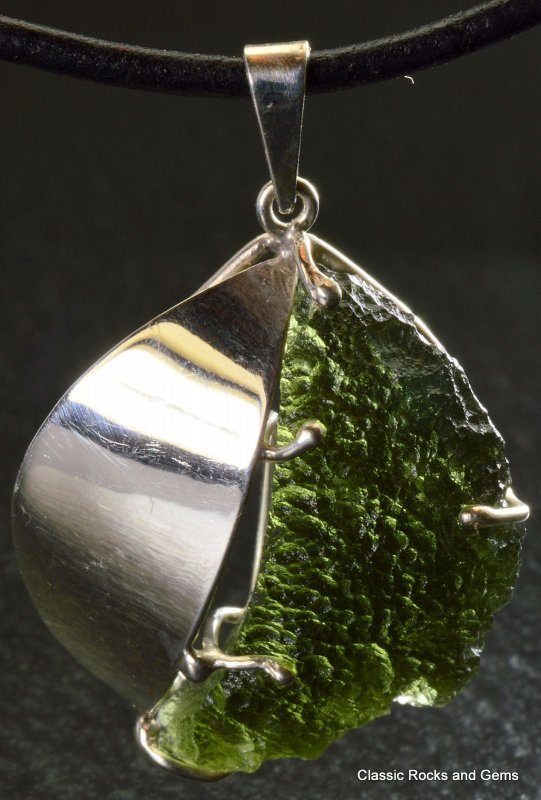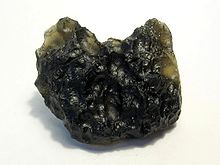Moldavite (Czech: Vltavín) is an olive-green or dull greenish vitreous substance possibly formed by a meteorite impact. It is one kind of tektite. They were introduced to the scientific public for the first time in 1786 as “chrysolites” from Týn nad Vltavou in a lecture by professor Josef Mayer of Prague University, read at a meeting of the Bohemian Scientific Society (Mayer 1788). Zippe (1836) first used the term “moldavite” derived from the town of Moldauthein (Czech: Týn nad Vltavou) in Bohemia (the Czech Republic), from where the first described pieces came from.
Origin
Moldavite's bottle-green glass colour led to its being commonly called Bouteillen-stein, and at one time it was regarded as an artificial product, but this view is opposed to the fact that no remains of glassworks are found in the neighbourhood of its occurrence; moreover, pieces of the substance are widely distributed in Middle to Upper Miocene and younger fluvial clays and gravelly sands in Bohemia and Moravia.
In 1900, F. E. Suess pointed out that the gravel-size moldavites exhibited curious pittings and wrinkles on the surface, which could not be due to the action of water, but resembled the characteristic markings on many meteorites. Boldly attributing the material to a cosmic origin, he regarded moldavites as a special type of meteorite for which he proposed the name of tektite. However, for a long time, it was generally believed to be a variety of obsidian. Because of their difficult fusibility, extremely low water content, and its chemical composition, the current overwhelming consensus among earth scientists is that moldavites were formed 15 million years ago during the impact of a giant meteorite in present-day Nördlinger Ries. Splatters of material that was melted by the impact cooled while they were actually airborne and most fell in central Bohemia—traversed by Vltava river (German: Moldau). Currently, moldavites have been found in area that includes southern Bohemia, western Moravia, the Cheb Basin (northwest Bohemia), Lusatia (Germany), and Waldviertel (Austria).[1] Isotope analysis of samples of moldavites have shown a beryllium-10 isotope composition similar to the composition of Australasian tektites (Australites)and Ivory Coast tektites (Ivorites). Their similarity in beryllium-10 isotope composition indicates that moldavites, Australites, and Ivorites consist of near surface and loosely consolidated terrestrial sediments melted by hypervelocity impacts.[2]
99 % of all moldavite finds have provided the South Bohemian localities, 1% were found in South Moravian localities. Only tens of pieces were found in the Lusatian area (near Dresden), Cheb basin area (West Bohemia) and Northern Austria (near Radessen). Principal occurrences of moldavites in Bohemia are associated with Tertiary sediments of the České Budějovice and Třeboň Basins. The most prominent localities are concentrated in a NW-SE strip along the western margin of the České Budějovice Basin. Majority of these occurrences are bound to the Vrábče Member and Koroseky Sandy Gravel. Prominent localities in the Třeboň Basin are bound to gravels and sands of the Domanín Formation. In Moravia, moldavite occurrences are restricted to an area roughly bounded by the towns of Třebíč, Znojmo and Brno. Taking into account the number of pieces found, Moravian localities are considerably less productive than the Bohemian ones; however, the average weight of the moldavites found is much higher. The oldest (primary) moldavite-bearing sediments lie between Slavice and Třebíč. Majority of other localities in southern Moravia are associated with sediments of Miocene as well as Pleistocene rivers that flowed across this area more or less to the southeast, similar to the present streams of Jihlava, Oslava a Jevišovka.
Use
The total amount of Moldavite scattered around the world is estimated at 275 tons. There is now only one sand pit, which (legally) produces moldavites. It is predicted that in less than ten years from now[when?] commercial Moldavite mining will come to an end. After this time, there will be virtually no appreciable amount of gem-grade Moldavite left in the ground.
There are typically two grades of moldavite: high quality, often referred to as museum grade, and regular grade. Museum and regular grade moldavite can be told apart by the way they look: The regular grade pieces are usually darker and more saturated in their green colour, and the surface is seen as closely spaced pitting or weathering. This type sometimes appears to have been broken apart from a larger chunk. Moldavite is also found to be compatible with borosilicate glass and can be fused to it with ease.
The museum grade has a distinct fern-like pattern and is much more translucent than the regular grade. There is usually a fairly big difference in the price between the two. The museum grade "flower bursts" are much more prized by the connoisseur. High-quality moldavite stones are often used in hand-crafted jewellery and thus enter the market away from mainstream jewellery fashions, more centred around art and craft, and as such have gained an almost cult status.
There is a new Moldavite museum in Český Krumlov, Czech rep..
*******************
Moldavites: Natural Or Fake?
Tectites are members of a large group of impact glasses, formed by the collision of a meteorite on the Earth’s surface and the subsequent melting of surrounding rocks. The most famous tectites used as gemstones are moldavites from southern Bohemia in the Czech Republic. These were formed by a meteorite’s impact in the Ries crater in southern Germany 14.7 million years ago, about 500 km from their occurrence (V. Bouška,
Moldavites: The Czech Tektites, Stylizace, Prague, 1994). Moldavites are popular for their pleasant green color, enigmatic origin, and interesting etched texture. They are used in jewelry, in either faceted or natural form. The price of moldavite has risen in the last few years, and as a logical consequence imitations have become more widespread.
In fact, moldavite imitations are nothing new. Faceted moldavites were very popular in Czech jewelry during the second half of the 19th century, often with Czech garnets (chrome pyropes) or small river pearls. Their use diminished in the beginning of the 20th century when imitations made from green bottle glass began to appear. Nevertheless, the author’s recent study of five moldavite sets (bracelet, brooch, and earrings) from the second half of the 19th century in the collection of the Museum of Decorative Arts in Prague revealed an unexpected result. Only one set contained moldavites—a donation to the museum by Olga Havlova, the first wife of Vaclav Havel, the late Czech author and statesman. All of the stones in the other four sets proved to be glass imitations. This means that glass imitations have been around decades longer than previously thought
Fortunately, the identification of faceted moldavite is simple. Besides their flow texture and abundant bubbles (almost always much more abundant than in an artificial glass), moldavites contain “wires” of lechatelierite, a high-temperature form of SiO
2. Lechatelierite is very easy to see with a loupe due to its lower RI.

Figure 2. Two moldavites from southern Bohemia, Czech Republic (top row) and two recent imitations from China (bottom row). The natural specimen on the top right measures 44 mm across. Photo by Jaroslav Hyršl.

Figure 3. One of two huge moldavite fakes seen in Hanoi. Photo by Jaroslav Hyršl.
The identification of moldavite with a natural-looking surface is much more difficult. Rumors of moldavite imitations from China have been circulating among Czech dealers for many years, but only recently has the author been able to study some examples (see figure 2). Two large moldavite imitations were seen in a high-end jewelry shop in Hanoi during the 2013 International Gemmological Conference (figure 3). Their size was astonishing, because very few real moldavites weigh more than 100 g. Their shape was also too perfect, making them easy to recognize.

Figure 4. Typical bubbles and inclusions of lechatelierite in natural moldavite; image width 5 mm. Photomicrograph by Jaroslav Hyršl.
Chinese producers are now manufacturing small stones weighing just a few grams that are very realistic. The surface feature of natural moldavite is caused by natural etching, and an almost identical feature can be created artificially, likely in hydrofluoric acid. If the stone in question has a polished surface, the presence or lack of lechatelierite “wires” (figure 4, top and bottom) is the best diagnostic tool, along with refractive index (table 1). For rough, immersion in water or especially oil with a similar RI is very helpful to reveal lechatelierite. Imitation moldavite also has a different density, UV-Vis absorption spectrum (figure 5), and fluorescence (again, see table 1). The color of natural moldavites is caused by very low concentration of iron; all other tectites are more Fe-rich and therefore black. Fluorescence is particularly helpful because it may be used on large mixed lots. Some imitations are not fluorescent, however. One imitation seen by the author several years ago was not fluorescent, but its very high specific gravity of 3.60 immediately ruled out natural moldavite.
| TABLE 1. Characteristics of natural and imitation moldavite. |
| | Moldavite | Chinese imitations | 19th-century glass imitations |
| Color | Light green to brown | Light green | Light green |
| RI | 1.490 (1.480–1.510) | 1.520 | 1.545–1.580 |
| Density | 2.35 (2.27–2.46) | 2.52–2.53 | n.a. |
| Fluorescence | Inert in UV | Chalky in short-wave UV | Inert in UV |
| Absorption spectrum | Minimum at 550 nm | Maxima at 460 and 640 | n.a.
|

Figure 5. Absorption spectra of natural moldavite (black and red lines) and imitations (green and blue lines).
About the Author
Jaroslav Hyršl is a mineralogist and author in Prague, and a regular Gems & Gemology contributor.



